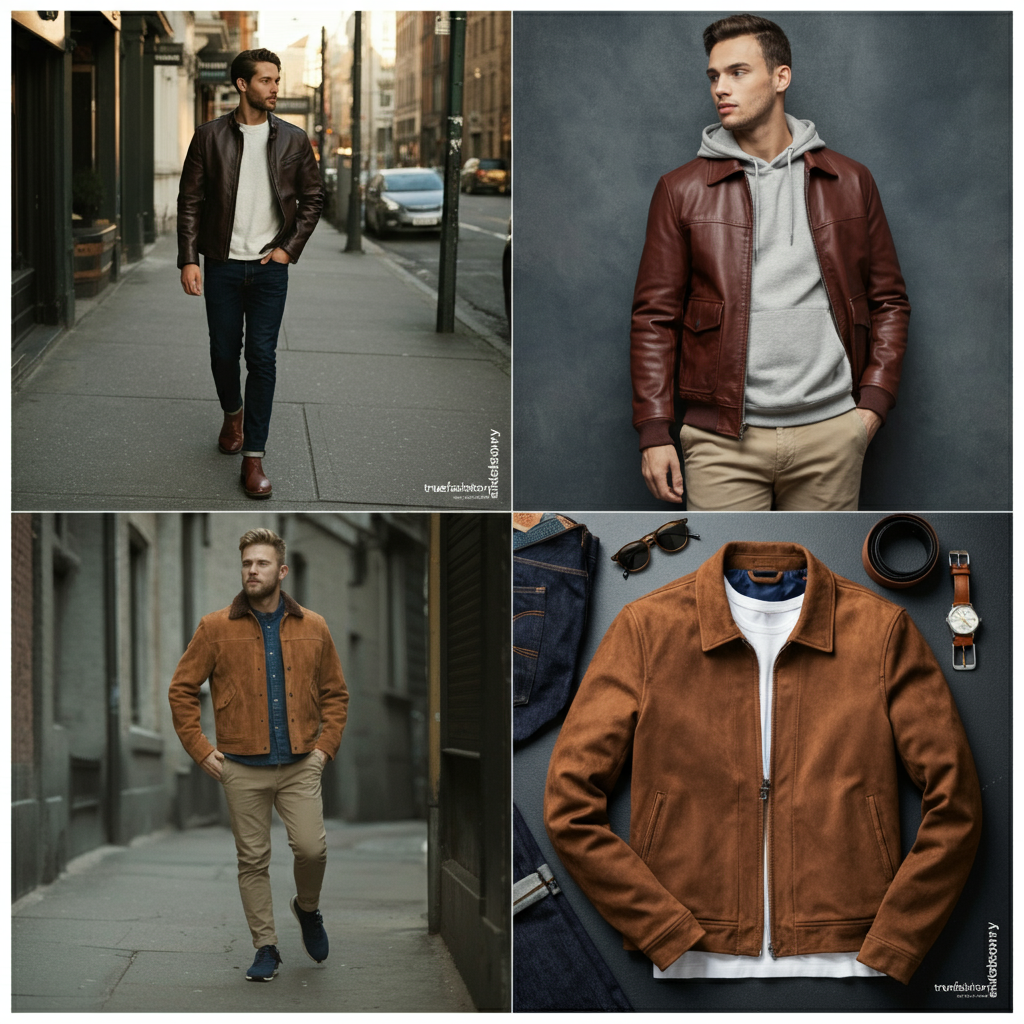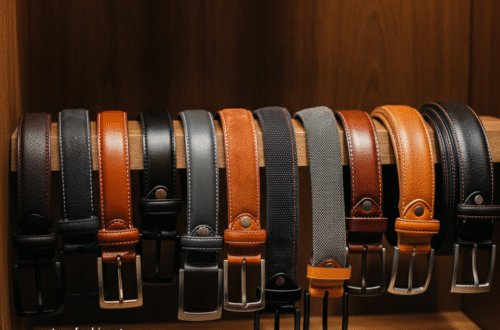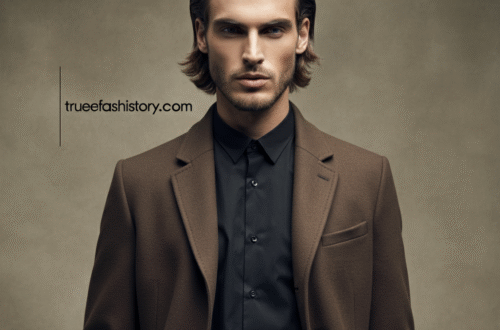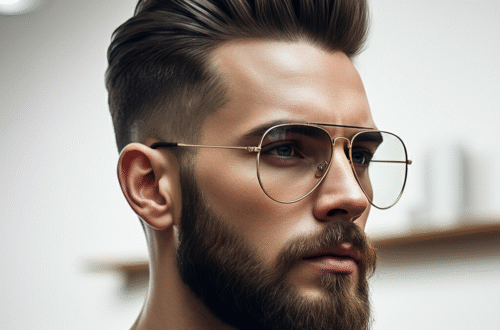A leather jacket is more than just an item of clothing; it’s a statement piece, an investment in timeless style, and a reliable companion for years of wear. While black leather often gets the spotlight, a leather jacket for men brown colour offers a level of versatility and warmth that is truly unmatched. It has a rich history, a rugged charm, and the unique ability to look better with age. This guide will walk you through everything you need to know, from choosing the right shade and style to caring for your jacket so it lasts a lifetime. For more deep dives into classic apparel, you can always explore other truefashionstory.com Blog style guides.
Whether you’re aiming for a smart-casual look for a weekend outing or a tough, durable layer for your daily adventures, the right brown leather jacket is out there. It pairs effortlessly with everything from crisp denim to tailored chinos, making it one of the most hardworking pieces in any man’s wardrobe.
Why a Brown Leather Jacket Is a Wardrobe Essential
A brown leather jacket is a cornerstone of men’s fashion for good reason. Unlike its black counterpart, which can sometimes feel formal or aggressive, brown leather exudes a relaxed, approachable confidence. It’s incredibly versatile, fitting seamlessly into various settings across different seasons in the US. In the crisp air of a New England fall, it’s the perfect outer layer over a flannel shirt. During a mild California winter, it works well with just a t-shirt. The natural, earthy tones of brown leather complement a wide range of colors, from blues and greens to grays and creams, making it easy to create cohesive outfits without overthinking it.
Furthermore, a leather jacket for men brown colour ages beautifully. Every scuff, crease, and mark it picks up tells a story, adding to its unique character. This patina effect is especially pronounced on high-quality, full-grain leathers, turning your jacket into a piece that is truly one-of-a-kind. It’s an investment that pays dividends in style and personality over the years, adapting to your life and becoming a signature part of your look. This jacket isn’t just a trend; it’s a timeless classic that remains relevant year after year.
Understanding Leather Types: From Full-Grain to Faux
Choosing a leather jacket starts with understanding the material itself. The type of leather determines the jacket’s durability, appearance, and how it will age over time. Getting familiar with these terms will help you make an informed decision.
Natural Leather Varieties
- Full-Grain Leather: This is the highest quality leather available. It comes from the top layer of the hide and includes all the natural grain. It’s incredibly durable and develops a beautiful patina over time. It’s tough, breathable, and built to last for decades if cared for properly.
- Top-Grain Leather: The second-highest grade, top-grain leather has had the very top layer sanded or buffed to remove imperfections. This makes it smoother and more uniform in appearance than full-grain, but slightly less durable as the strongest fibers are removed. It’s a popular choice for its clean look and resistance to stains.
- Corrected-Grain Leather: This leather has had an artificial grain applied to its surface after being sanded to remove blemishes. It’s often finished with stains or dyes to create a uniform appearance. While less expensive, it doesn’t have the natural feel or breathability of higher-grade leathers.
- Suede and Nubuck: Both are known for their soft, velvety texture. Suede is made from the underside of the animal hide, making it softer and less durable. Nubuck is top-grain leather that has been sanded on the outside to give it a slight nap. Nubuck is more durable than suede but requires careful maintenance to protect its finish.
Genuine vs. Faux Leather
The term “genuine leather” can be misleading. While it is real leather, it is typically a lower-quality grade made from the remaining layers of the hide after the top layers are split off. It’s less durable and doesn’t age as well as full-grain or top-grain leather. In contrast, faux leather (or vegan leather) is a synthetic material, usually polyurethane (PU). It’s a great cruelty-free, budget-friendly alternative. Modern faux leathers can look surprisingly realistic, but they lack the breathability, durability, and unique aging qualities of real leather.
Finding the Perfect Shade of Brown
Brown is not a single color; it’s a spectrum of rich, earthy tones. The right shade can completely define the character of your jacket and how you style it.
- Dark Chocolate: A deep, dark brown is a sophisticated and versatile choice. It functions almost like black but with a softer edge. It pairs exceptionally well with dark-wash denim, gray wool trousers, and charcoal sweaters for a refined, classic look.
- Cognac or Whiskey: These medium-brown shades have warm, reddish-orange undertones. They are vibrant and full of character, making a bold statement. A cognac leather jacket looks fantastic with light-wash jeans, an off-white t-shirt, and brown boots, creating a rugged yet polished aesthetic.
- Tan: A lighter brown, tan is a more casual and approachable option. It’s perfect for spring and early fall. It complements blue denim beautifully and works well with pastel shirts and white sneakers for a fresh, modern vibe.
- Distressed Brown: Some jackets come pre-distressed, giving them a worn-in, vintage look from day one. This style is inherently casual and is best suited for rugged outfits, such as those with work boots, faded jeans, and a simple Henley shirt.
When choosing a shade, consider your existing wardrobe. If you wear a lot of dark, neutral colors, a cognac jacket can add a pop of warmth. If your closet is full of lighter tones, a dark chocolate brown will provide a strong, grounding element.
How a Leather Jacket for Men Brown Colour Should Fit
Fit is the most critical element of a great leather jacket. An ill-fitting jacket, no matter how expensive, will never look right. Here’s what to look for to ensure a perfect fit.
Key Fit Points
- Shoulders: The shoulder seams should sit exactly on the edge of your shoulders. If they hang over, the jacket is too big. If they sit up on your shoulder blades, it’s too small.
- Chest: You should be able to comfortably zip the jacket up without it feeling restrictive. Aim for about one to two inches of “ease” or extra space, which allows for light layering with a sweater or hoodie.
- Sleeve Length: The sleeves should end right at the wrist bone or the base of your thumb. This allows a watch or the cuff of a shirt to peek out. Sleeves that are too long will bunch up and look sloppy.
- Jacket Length: For most styles like bombers and racers, the hem of the jacket should hit right at your belt line or the top of your hips. Longer styles like field jackets will extend further down.
Layering Considerations
Think about how you plan to wear your jacket. If you live in a colder climate and intend to layer it over thick sweaters or hoodies, you may want to size up slightly or look for a jacket with a more generous cut. However, be careful not to go too large, as the jacket might look bulky when worn with just a t-shirt. The ideal fit is snug but not tight, allowing for both comfort and a clean silhouette. Remember that leather will stretch and mold to your body over time, so a slightly snug fit initially is often a good thing.
Popular Brown Leather Jacket Styles
Different styles of leather jackets serve different purposes and create distinct looks. Here’s a breakdown of the most popular options.
Brown Leather Jacket Style Comparison
|
Style |
Typical Fit |
Best For |
Key Details |
How It Looks With Jeans/Chinos |
|---|---|---|---|---|
|
Biker |
Snug, often asymmetrical |
Casual, edgy looks |
Asymmetrical zipper, wide lapels, belts, lots of zippers |
Excellent with slim or straight-leg jeans. Creates a classic, rebellious look. |
|
Bomber |
Relaxed, blouson-style |
Versatile, everyday wear |
Ribbed cuffs and hem, front zipper, simple collar |
Pairs perfectly with both jeans and chinos for a relaxed, timeless style. |
|
Racer |
Minimalist, slim-fit |
Sleek, modern outfits |
Center front zipper, small snap collar, clean lines |
Looks sharp with slim-fit jeans or chinos for a streamlined, contemporary feel. |
|
Field/Utility |
Longer, looser fit |
Practical, rugged wear |
Multiple front pockets, often belted, shoulder epaulets |
Best with durable jeans or canvas pants. Leans more utilitarian than formal. |
|
Trucker |
Boxy, hip-length |
Casual, vintage-inspired |
Pointed collar, button front, two chest pockets |
A great match for relaxed-fit jeans or corduroys for a retro workwear vibe. |
The Biker jacket is iconic, defined by its rebellious spirit. The Bomber is arguably the most versatile, easily dressed up or down. The Racer offers a clean, minimalist aesthetic, while the Field jacket is practical and utilitarian. The Trucker, often seen in denim, has a unique and rugged charm when crafted from brown leather or suede.
Caring for Your Brown Leather Jacket
Proper care is essential to protect your investment and ensure your jacket lasts for decades. Leather is a natural skin, and it needs to be cleaned and conditioned to stay supple and healthy. Following a few simple rules will keep it looking its best.
Cleaning and Conditioning
- For small spills or dirt, wipe the area immediately with a soft, damp cloth.
- For a deeper clean, use a cleaner specifically designed for leather. Apply a small amount to a cloth and gently wipe the jacket. Always test any product on an inconspicuous area first, like the inside of a cuff.
- Condition your jacket once or twice a year with a quality leather conditioner. This replenishes the natural oils, preventing the leather from drying out and cracking. Use a small amount and rub it in with a soft cloth in a circular motion. Let it absorb for a few hours before wiping off any excess.
Storage and Weatherproofing
- Store your jacket on a wide, padded hanger to help it maintain its shape. Avoid thin wire hangers, which can stretch the shoulders.
- Never store a leather jacket in a plastic bag or container. Leather needs to breathe, and plastic will trap moisture, which can lead to mildew. A cloth garment bag is a much better option.
- While leather has some natural water resistance, it’s not waterproof. You can apply a waterproofing spray designed for leather to add a layer of protection against rain and snow. Reapply this spray seasonally if you live in a wet climate. More in-depth instructions can be found in our truefashionstory.com Blog care tips.
A Buyer’s Checklist: What to Look For
When you’re ready to purchase a brown leather jacket, keep this checklist in mind to ensure you’re getting a quality piece.
- Leather Quality: Feel the leather. High-quality leather should feel soft, supple, and substantial. Look for full-grain or top-grain for the best durability and aging potential.
- Hardware: Check the zippers, snaps, and buckles. They should feel heavy and operate smoothly. Reputable brands often use high-quality hardware from manufacturers like YKK.
- Stitching: Examine the seams. The stitching should be neat, tight, and consistent, with no loose threads. This indicates good craftsmanship and ensures the jacket won’t fall apart.
- Lining: The interior lining should be comfortable and durable. Common materials include cotton, rayon, and polyester. A well-made jacket will have a lining that is stitched securely with no pulling or tearing.
- Brand Transparency: A good brand is open about where its leather comes from and how its jackets are made. This transparency is often a sign of ethical sourcing and quality manufacturing.
- Return Policy: Especially when buying online, make sure the retailer has a fair return policy. This gives you the chance to try the jacket on at home and ensure the fit and quality are right for you.
Budget vs. Premium: What to Expect
The price of a leather jacket can range from under a hundred dollars to several thousand. The cost is primarily determined by the quality of the leather, the hardware, the craftsmanship, and the brand name.
- Budget-Friendly Options ($100 – $400): In this range, you’ll mostly find jackets made from faux leather, genuine leather, or lower-grade corrected-grain leather. The craftsmanship might be less refined, with simpler hardware and linings. These can be a great entry point, but they won’t offer the same longevity or aging character as more expensive options.
- Mid-Range Options ($400 – $900): This is the sweet spot for many buyers. Here you can find excellent jackets made from high-quality top-grain or even full-grain leather. The construction is solid, the hardware is reliable, and the fit is generally more precise. These jackets offer a great balance of quality and value.
- Premium Options ($900+): At this level, you’re paying for the best of the best. This includes superior full-grain leathers from renowned tanneries, exceptional hand-finished details, luxurious linings, designer branding, and meticulous craftsmanship. These are heirloom pieces designed to last a lifetime and beyond.
Sustainable and Ethical Considerations
The conversation around fashion is increasingly focused on sustainability, and leather is a complex topic within that discussion. When shopping, you can make more conscious choices.
Vegetable-tanned leather is a more environmentally friendly alternative to the common chromium-tanning process, which uses harsh chemicals. It relies on natural tannins from tree bark and other plant matter. This process is slower but produces a beautiful leather that develops a unique patina. Another key aspect of sustainability is longevity. A well-made leather jacket is the antithesis of fast fashion. By investing in a high-quality piece that you will wear for many years, you reduce waste. When it’s time for a change, consider having your jacket professionally repaired or altered rather than replacing it. Finally, the secondhand market for leather jackets is robust. Buying a pre-owned jacket is a fantastic way to get a high-quality piece at a lower price while promoting a circular economy.
Seasonal Styling with a Brown Leather Jacket
The versatility of a brown leather jacket makes it a year-round staple, with just a few adjustments for the season.
- Fall: This is prime leather jacket season. Pair it with a chunky knit sweater, dark denim, and sturdy boots for a classic autumnal look. The brown tones harmonize perfectly with the colors of the season.
- Winter: For colder weather, layering is key. Wear your jacket over a hoodie or a thin down vest for extra insulation. A darker chocolate brown jacket can look especially sharp against a snowy backdrop.
- Spring: As the weather warms up, lighten your layers. A tan or cognac leather jacket over a simple white t-shirt or a light-colored button-down shirt with chinos is a perfect spring combination.
- Summer: While a leather jacket might seem too heavy for summer, it can be a great evening piece. On a cool summer night, drape it over your shoulders or wear it with a lightweight linen shirt and shorts for a surprisingly stylish look.
Key Takeaways
- A leather jacket for men brown colour is a highly versatile and timeless wardrobe staple that offers a softer, more approachable alternative to black.
- Fit is paramount. Ensure the jacket is snug but comfortable across the shoulders, chest, and arms, with sleeves ending at the wrist.
- Understand the difference between leather types. Full-grain and top-grain offer the best durability and will age beautifully, developing a unique patina.
- Choose a shade of brown (like dark chocolate, cognac, or tan) that complements your existing wardrobe and personal style.
- Invest in quality craftsmanship, including durable hardware and neat stitching, to ensure your jacket lasts for years.
- Proper care, including regular conditioning and correct storage, is essential for maintaining the health and appearance of the leather.
Frequently Asked Questions (FAQ)
1. Is a brown leather jacket still in style?
Absolutely. A brown leather jacket is a timeless classic that transcends seasonal trends. Its rugged and versatile nature ensures it remains a staple in men’s fashion year after year. Styles like the bomber, biker, and racer have been popular for decades and continue to be relevant. The key is to choose a classic cut that suits your body type and personal style.
2. What color pants go best with a brown leather jacket?
Brown leather jackets are incredibly versatile. They pair exceptionally well with all shades of blue denim, from light wash to dark indigo. They also look great with chinos in colors like khaki, navy, gray, and olive green. For a more dressed-up look, you can even pair a dark chocolate brown jacket with charcoal wool trousers. Avoid matching the exact shade of brown in your pants.
3. How do I break in a stiff leather jacket?
The best way to break in a new leather jacket is simply to wear it as much as possible. Your body heat and movement will naturally soften the leather and help it mold to your shape. To speed up the process, you can try wearing it around the house or gently bending and flexing the arms and torso. Applying a quality leather conditioner can also help soften the hide.
4. Can I wear a brown leather jacket in the rain?
While leather has some natural water resistance, it is not waterproof and can be damaged by excessive moisture. A light drizzle is usually fine, but you should avoid wearing your jacket in a heavy downpour. If it does get wet, let it air dry naturally at room temperature. Never use a hairdryer or place it near a radiator, as direct heat can cause the leather to crack. Applying a waterproofing spray can add extra protection.
5. How can I tell if a leather jacket is good quality?
Look for a few key indicators. High-quality leather feels supple and has a pleasant, earthy smell, not a chemical one. Check the stitching; it should be even and tight with no loose threads. The hardware, like zippers and snaps, should feel substantial and work smoothly. Finally, consider the source—jackets made from full-grain or top-grain leather are typically of higher quality than those labeled only as “genuine leather.”
6. Should I choose a biker or a bomber style?
This depends on your personal style and intended use. The biker jacket has an edgy, rebellious feel with its asymmetrical zip and wider lapels, making it great for casual, statement looks. The bomber jacket is more classic and understated, with a relaxed fit and ribbed cuffs. It’s incredibly versatile and can be easily dressed up or down, making it a safe and stylish choice for everyday wear.





